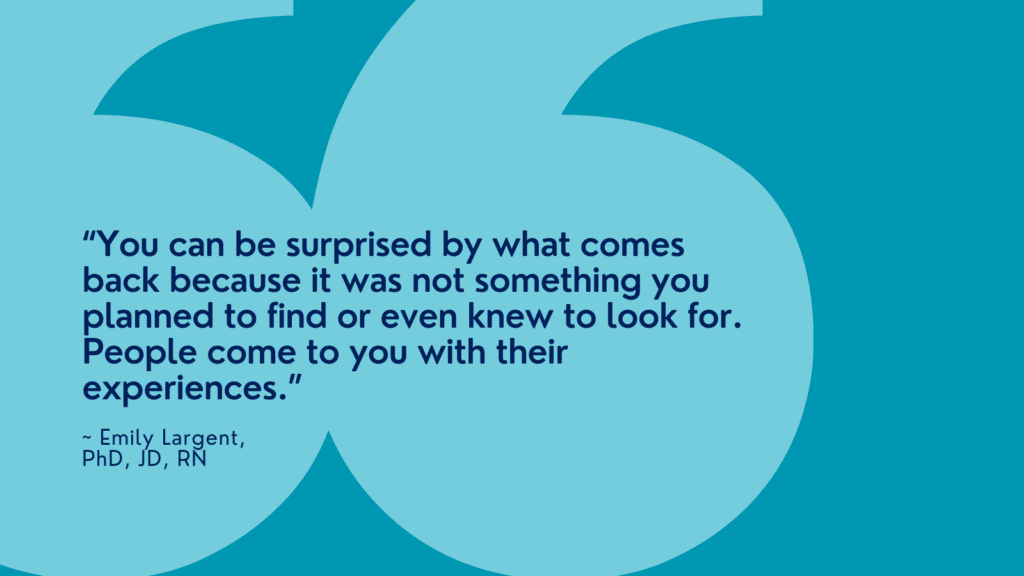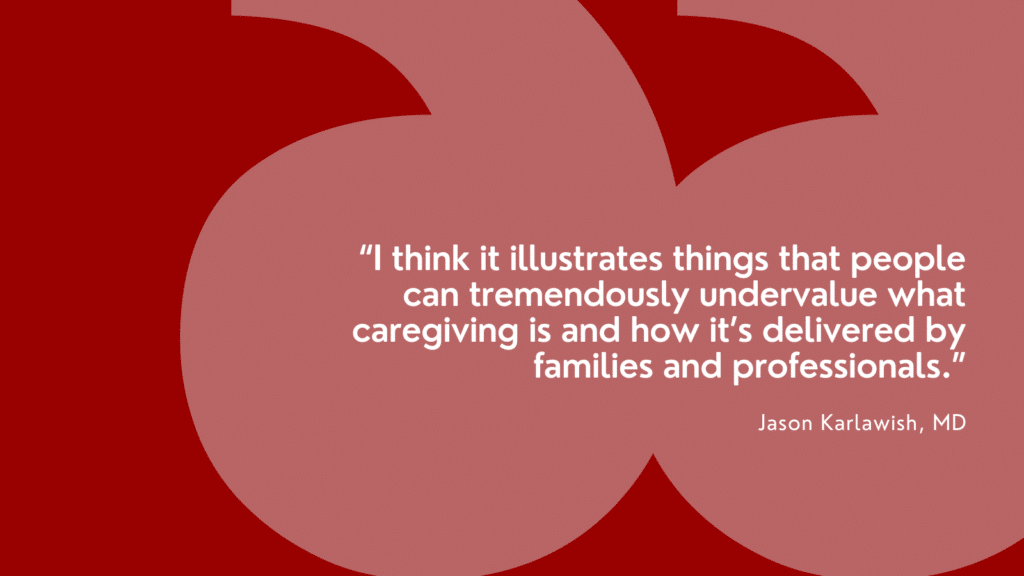By Meghan McCarthy
Four years ago, SARS-CoV-2, the virus that causes Coronavirus disease (COVID-19), brought the world to a halt.
Grocery stores became eerily quiet. Masks and disinfectants sold out. Social distancing became the norm, and Zoom became a household name. The news became saturated with harrowing stories of overwhelmed hospitals and grim toll on patients.
In the four years since March 2020, researchers have documented and explained the long-term impact of COVID-19 on individuals’ health and wellbeing. Patients skipped routine checkups and annual screenings. Clinician burnout soared to an all-time high.
For individuals with Alzheimer’s disease and related dementias (ADRDs), the pandemic accelerated symptom progression, limited access to medical care, and increased isolation. But what about their caregivers?
A member of the Alzheimer’s Disease Research Center (ADRC) and Perelman School of Medicine Professor Emily Largent, PhD, JD, RN, and Penn Memory Center (PMC) Co-Director Jason Karlawish, MD, set out to understand the caregiver experience in their recently published COVID Caregiving study.
Background
“Caregiving seems self-evident,” Dr. Karlawish said. “Of course you do it, it’s what families do. The pandemic was, in some sense, like disrupting parenting. It was an experiment: What if you disrupted people’s ability to care?”
As the pandemic continued beyond March 2020, Drs. Largent and Karlawish reached the same conclusion. Research must be done to understand the experience of caregivers.
They wanted to understand the day-to-day realities, challenges, and sources of resilience among caregivers. “Ultimately, all of these questions were meant to inform a larger one: What are the ways that we can better support care partners for persons living with dementia?” Dr. Largent said.
The team interviewed 40 caregivers of patients cared for at PMC. Two-thirds of these caregivers were caring for a person with dementia in the community, while the remaining third was caring for a person who lived in long-term care. The team initially estimated 45-minute interview windows. They quickly discovered people wanted to talk. Caregivers were eager to share their insights and – in the midst of their isolation – talk to someone about their experiences. Many conversations extended over two hours.
The PMC research team analyzed the interviews using two approaches. First, the team assessed how interviews confirmed or contradicted current literature on caregiver experience. Second, they discerned distinct themes across groups while also identifying shared experiences.
“The benefit of this kind of open-ended data collection is people have so much space to expand on the topics important to them,” Dr. Largent said. “You can be surprised by what comes back because it was not something you planned to find or even knew to look for. People come to you with their experiences.”
A trio of findings
Drs. Largent and Karlawish identified three distinct groups of caregivers.
First, nearly half of the caregivers for community-dwelling persons with dementia maintained a steady caregiving routine.
“For caregivers whose experience was characterized by a continuity of caregiving routines, many described a consistency in cognitive and functional impairments of the person living with dementia who was in their care,” Dr. Largent said.
Feelings of frustration, powerlessness, and burnout characterize this group. Interviews revealed caregivers grappling with intensified demands, leading to role imbalance. “They felt like they lost their own identity,” Dr. Largent said.
The second group experienced heightened awareness of their caregiving role due to the pandemic. This group faced disrupted caregiving when isolated with people living with dementia due to many factors.
As jobs became remote, caregivers spent more time with people living with dementia and lost opportunities for respite. As formal care, such as a paid caregiver or an adult day program, decreased, caregiving tasks increased. Often, these caregivers reported that their loved one exhibited an acceleration in cognitive decline.
At the same time, if negative feelings impacted interactions with loved ones, these caregivers felt guilt and worry.
One poignant example involved a daughter struggling to balance work from home with caring for her mother.
The daughter watched her mother slowly decline as the pandemic continued.
“I choked up reading about it,” Dr. Karlawish said. “Pandemic hits and the daycare shuts down, but her daughter has to work and as she does, she witnesses her mother’s decline accelerate. I think it illustrates things that people can tremendously undervalue what caregiving is and how it’s delivered by families and professionals.”
Yet, even amidst these challenges, many found pride in their resilience and gratitude for the time spent with their loved ones.
Finally, some caregivers discussed disrupted caregiving when isolated from people living with dementia.
“Instead of being pushed together like the community-dwelling caregivers and persons living with dementia, we saw that caregivers for persons living in long-term care had been forced apart from their loved one, which created a different set of difficulties and strains,” Dr. Largent said. “As one person poignantly told us, ‘I didn’t put my husband in a long-term care facility because I didn’t want to take care of him.’”
Many caregivers who offered support to loved ones in long-term care facilities worried about the quality of care their loved ones received during the pandemic. They worried about the lack of socialization and questioned who helped people living with dementia eat at mealtimes. They worried about little details like trimmed fingernails and who could play their loved ones’ favorite music—tasks they normally managed during visits. Who was doing it now?
“The pandemic revealed how understaffed places were,” Dr. Karlawish said. “So many places essentially were relying on family coming in. Data from long-term care exposed the important value of family and a hidden in plain sight workforce that many facilities were taking advance of.”
Some caregivers experienced the devastating loss of the person in their care.
Losing a loved one during this time carried heavy emotions, especially when loved ones were separated. Caregivers grieved the reality of death, and in some cases, their inability to be with their loved one when they passed away. “It led to a complicated grieving process,” Dr. Largent said.
“Death is one kind of loss, but it was not the only loss,” Dr. Largent observed, “Caregivers talked about how much they missed being able to hold hands and hug their loved ones. They lost time – whether because they were kept apart or because they felt the pandemic accelerated their loved one’s decline. It’s important to honor all of the dimensions of loss that people experienced.”
The team also found that socioeconomic considerations were woven throughout their findings. Dementia often entails uncompensated costs. For example, some families have the means to pay for adult day services while others do not. The pandemic resulted in new financial pressures for caregivers, especially as many faced lost jobs or reduced working hours.
“We saw that there was strain for people who now wondered how they were going to meet even basic expenses like food and rent,” Dr. Largent said. “They were experiencing significant financial worry in addition to their heightened caregiving responsibilities. That was a difficult combination.”
Overarching experiences of gratitude and loss
Given the emotional nature of these conversations, Dr. Largent is grateful to all 40 caregivers who shared their stories.
“It was an exceptionally meaningful project to work on, and I’m so appreciative of people’s candor and honesty,” Dr. Largent said. “They shared things that were good, bad, and indifferent. Their willingness to share with us made such a rich contribution to the literature.”
Such gratitude extends beyond study participants to include the PMC research team that prioritized this project during such a trying environment in healthcare. “I look back on that awful year, and we really rallied,” Dr. Karlawish said. “This wasn’t on our list of projects, but it became clear very quickly that there was something going on that we needed to study — that’s our job as academics. I take a small pride in that.”
To read the full manuscript, please click here.



